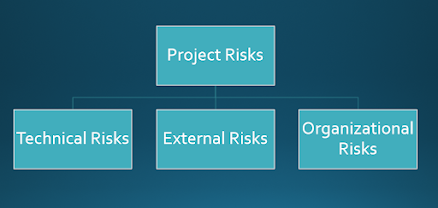Poor risk management has the ability to severely impact your project.
Impacts of poor risk management leads to:
- Poor User Adoption
- Unrealized Benefits
- Late-running Projects
- Overspent Budgets
- Unhappy Clients
- Reputational Damage
- Project Failure
You could lose enormous investment dollars if you fail to anticipate the risks the project.
You could suffer irreparable damage to your company's reputation by failing to prepare to manage difficulties.
It is the job of every project manager to come up with alternate plans that the team may adopt if the project begins to spiral out of control.
Having a project risk management system helps in identifying the types of risks and mitigating them. Having a contingency plan in place is critical.
This plan should identify all risks that the course of action to be taken if they materialize it.
The risk will be any one below category:
Follow below Risk Management Process:
Strategies for managing risk:
Avoid
When you avoid the risk it means you change your plan to completely eliminate the probability of the risk occurring or the effect of the risk if it does occur.
Transfer
Risk transference occurs when the negative impact is shifted to a third party, such as through an insurance policy or penalty clause in a contract. The risk may still occur however the financial impact will be somewhat displaced.
Risk transference usually involves some type of contractual agreement.
Mitigate
Risk mitigation occurs when you proactively change the plan to minimize the impact or probability of the risk occurring. Risk mitigation does not eliminate the risk and as such there will be some residual risk remaining.
A mitigation plan is proactive and aims to prevent or minimize the impact of a risk, while a contingency plan is reactive and addresses risks that have already occurred.
A mitigation plan is a risk response strategy that reduces the likelihood or impact of a risk occurring. For example, wearing a helmet or seatbelt is a mitigation plan.
A contingency plan is a risk response strategy that outlines specific actions to be taken if a potential risk becomes a reality. For example, applying for accident insurance is a contingency plan.
There are three proactive approaches to handling a negative risk, also called a threat:
Avoid – eliminate the risk
Transfer – shift the impact to a 3rd party
Mitigate – decrease the probability or impact


Comments
Post a Comment